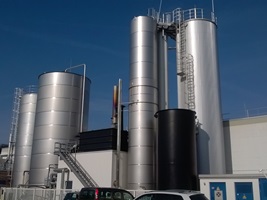For sewage treatment of organically high polluted wastewater, the anaerobic digestion has clear advantages against conventional aerobic sewage treatment.
By aerobic wastewater treatment, the carbon compounds of the wastewater are transferred by microorganisms mainly into CO2 and bacterial biomass, known as surplus sludge.
In the anaerobic technique, however, the carbon content in wastewater is converted by microorganisms into biogas (mainly CH4 and CO2) and the excess sludge content is very low.
Even if the energy supplied in the form of process heat is often higher than the energy that is produced in the form of biogas, the potential for savings is so great that the use of this technology for the pre-treatment of highly polluted organic process effluent could be profitable.
With so-called UASB (upflow anaerobic sludge blanket) fermenters or anaerobic filters, degradation rates of COD loads with up to 95% could be reached in relatively short retention time.


Such plants are typically found on food factories or in the beverage industry, but also in paper mills.
The use of an anaerobic wastewater pre-treatment should be examined separately for each individual case.
Potential savings by anaerobic wastewater treatment
(Einsparpotenziale durch anaerobe Abwasserbehandlung)
Presentation by Anselm J. Gleixner and Stefan Reitberger at Zentrum Energie, TerraTec 99, Leipzig on March the 2nd 1999.
>>Sorry this text is only available in German<<



